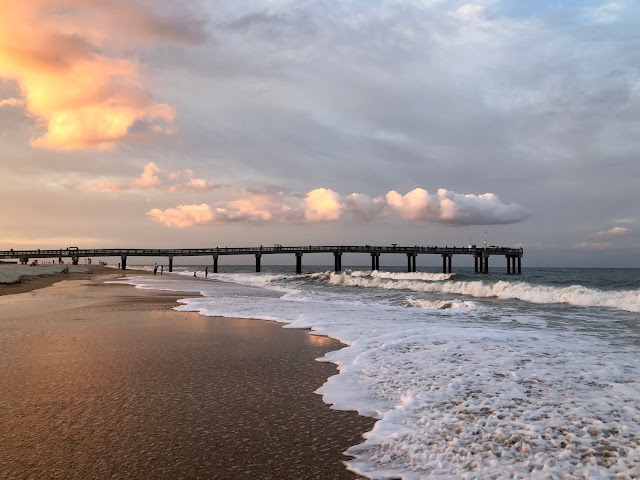 |
| St. Johns County Ocean Pier on St. Augustine Beach. |
Every year, for the past few years, my family tries to go south for some warm weather and sunshine during the school's spring break. Florida has been our primary destination since there is something for everyone to enjoy in our family. One of my favorite places to stop is St. Augustine!
Founded in 1565, St. Augustine is one of the oldest permanent European settlements in the continental United States. This little city contains the original Ripley's Believe It Or Not! museum, one of the oldest forts in the country, the narrowest street in the country (Treasury Street), and even the oldest wax museum. It's even thought to be the legendary location of Ponce de Leon's Fountain of Youth.
I tried finding the fountain, but no luck. Instead, here are a couple of highlights from our stay.
Castillo de San Marcos
 |
| Castillo de San Marcos. |
Tucked away on the mouth of the Matanzas River sits the oldest masonry fort in the continental United States, Castillo de San Marcos. The fortress was built in the late 17th century when the city of St. Augustine was still under Spanish rule. There are four bastions, two facing towards land and two facing towards the Saint Augustine Inlet. The bastions allowed for more cannons and artillery to be placed along the wall while also providing better range and coverage. In 1740, there were around 70 cannons sitting atop the walls of the fort with the largest having a reach of over 3 miles. To put that into perspective, the distance between the fort and the mouth of the inlet is under 2 miles. Enemy ships approaching could be hit a mile before they even reached the mouth.
 |
| My dad outside the main entrance to the fort. |
One of the most unique features about the fort is that it is only one of two worldwide that is constructed from coquina. Coquina is a soft type of limestone consisting of broken shells, corals, fossils, and small rock fragments. These fragments create air pockets, making it porous. At the time of construction, coquina was an abundant source, and while it may not seem practical to have a fort made of porous and soft materials, it proved to be a formidable defender against heavy artillery. The softness of the limestone absorbs impact, reducing the amount of overall destruction to the structure. Instead of cannon balls shattering the walls of the fort, they were absorbed into the sides, stuck to the structure.
 |
| You can see bits of shells in the coquina walls of the fort. |
So now you have a fort that can't be burned down or blown up. That would explain why it's still standing!
Castillo de San Marcos changed hands numerous times over its first 200 years. First built by the Spanish, it was then acquired by the British in 1763 along with the rest of Florida. In 1783, Florida was returned to Spain, but was soon after turned over to the United States in 1819. The fort has since stayed under control of the U.S., but did change hands over to the Confederacy during the Civil War and then back to the Union afterwards.
● ● ● ● ● ● ● ● ● ●
Fun Fact: Although the fort changed hands a total of six times, it was never able to be taken by force due to it's unique design.
● ● ● ● ● ● ● ● ● ●
 |
| The small drawbridge entrance to the fort. |
The entrance to the fort is Sally Port, and to get there you have to cross the drawbridge. Defending the entrance is a total of two drawbridges (one large and one small), a ravelin, and a portcullis. The very base of the walls can be anywhere from 14 to 19 feet thick, so the only way in and out was through Sally Port. Immediately inside are the guard rooms and a room that once served as a jail for the city of St. Augustine.
Exhibits throughout the fort are broken up by era and country. Each time the fort was occupied by a different country, it underwent remodeling to accommodate the new dominant culture. Artifacts are scattered throughout the different rooms and in some areas you can still see carvings in the walls from prisoners, soldiers, and townspeople.
 |
| The gate guard living quarters right inside Sally Port. |
 |
| One of the staged rooms to show what the British occupation of the fort would have looked like. |
In one corner room is the original powder magazine which housed the gunpowder from 1675 to 1687 when the fort was first built. The room was designed to protect the powder from enemies, but what happens when you have a room right on the water with no ventilation? Moisture buildup. It's hard to use wet gunpowder! The original room is accessible to the public, but it's a pretty narrow passage. Scarlett went inside to check it out and confirmed it is indeed very humid in there.
 |
| Cannons previously used the walls. |
We worked our way through every room on the lower level and headed up the stairs to walk around the wall and bastions. There are all kinds of different cannons and mortars along the walls, most of them being of Spanish origin. Each one was cast individually so no two are exactly the same. On the corner of three bastions sits a sentry tower, and on the corner of the San Carlos Bastion is a watch tower where a beacon light burned at night, illuminating the immediate area.
 |
| The story of each cannon can be told by it's markings. |
 |
| The girls checking out one of the many mortars. |
 |
| Looking inside the fort from the walls. |
On our way out, I noticed that the bathrooms inside the fort are located almost right next to the original bathrooms built by the Spanish. The original restrooms of the fort used the tides to flush waste away from the pits through a sewer. When the tides came in, water came through the sewer and into the pit. As the tides went back out, it pulled the waste out with it. Just imagine swimming in the bay with all of that...
 |
| The outside walls of the fort and two bastions, facing the inlet. |
St. Augustine Beach
 |
| Walking from the hotel to the beach. |
St. Augustine Beach on Anastasia Island is one of my favorite beaches along the eastern coast of Florida (my other being Flagler Beach). We stayed right on the beach at the Hampton Inn, conveniently right across the street from my favorite restaurant, Sunset Grille. Their lobster ravioli is delicious and so, so rich! I had the bang bang shrimp this time as well and I easily could have just stayed there stuffing my face the whole time we were in St. Augustine.
A1A Beach Boulevard has a tremendous amount of options for food and ice cream. One highly recommended place is Les Petits Pleasures, a French style bakery and cafe that sits just between Anastasia State Park and the more commercial restaurant and shopping areas.
 |
| The Sunset Grille across from the hotel. |
 |
| Taking the girls to grab ice cream at Rita's |
The beach was just a short walk across the dunes from the back of our hotel. It's a fairly wide beach, so even during peak times, so it never feels overly crowded. This could also be due to the fact that it's not usually the first beach in Florida that comes to mind when planning a vacation. Daytona Beach, Cocoa Beach, Miami Beach, and Venice Beach are the more popular - and expensive - destinations. St. Augustine has the same silky soft sands without the crowds and without emptying your pockets.
 |
| Scarlett at the top of the dunes. |
 |
| Right before the borders of Anastasia State Park. |
Heading north along the beach is St. Johns County Ocean Pier and a little further past that is Anastasia State Park. The park is a protected wildlife area, and while there is access to certain spots for hiking and camping, other areas are prohibited because of protected nesting grounds. There are 195 different species of birds that call the area home, some of which make their nests right on the beach. We were visiting during the beginning of the least tern's nesting season, so parts of the beach was roped off.
Should you continue on through the park instead of the beach, you can eventually make your way over to the St. Augustine Lighthouse which sits on the inside of Salt Run. While I did not venture that far, my nephew made the 6 mile round trip trek to check it out. To say he was exhausted when he got back would be an understatement!
 |
| Sunrise with storms beginning to roll in. |
There is so much rich history and beauty in this little coastal area that sits just an hour south of Jacksonville. It is definitely worth a visit!





















Comments
Post a Comment